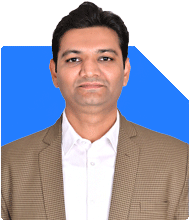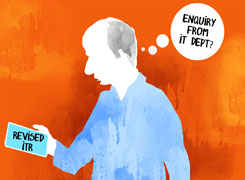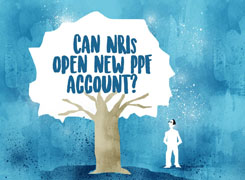Ramalingam Kalirajan |8442 Answers |Ask -Follow
Mutual Funds, Financial Planning Expert - Answered on Jul 10, 2024
He has an MBA in finance from the University of Madras and is a certified financial planner.
He is the director and chief financial planner at Holistic Investment, a Chennai-based firm that offers financial planning and wealth management advice.... more

Hi. I am here for an expert opinion. I am 40 yrs old male currently earning around 1.5 to 2.5 lac per month ( variable self employed). I have only Rs. 10 lac as saving right now. Have no big loans. Just one bike emi of Rs. 9000 which will close next year March. I can save at max 1 lac per month. Am I too late to save for my retirement and for child education ( child is 2.5 years of age)? What strategy can I apply for my retirement planning and child education. I am willing to retire at 60yrs of age.
Current Financial Situation
You earn Rs. 1.5 to 2.5 lakhs per month, which gives you a good income base to work from.
You have Rs. 10 lakhs in savings and a bike EMI of Rs. 9000 that will end next year March.
With the ability to save Rs. 1 lakh per month, you’re in a strong position to build a solid financial future.
Retirement Planning
Setting Goals
Retiring at 60 gives you 20 years to save. Start by estimating your retirement needs. Consider factors like lifestyle, health care, and inflation.
Assume you need Rs. 1 lakh per month post-retirement, adjusted for inflation. This will help you set a clear savings target.
Investment Strategy
Mutual funds are a good option for retirement planning. They offer growth potential and the power of compounding.
Equity Mutual Funds: These funds invest in stocks and have the potential for high returns. They are suitable for long-term goals like retirement.
Balanced Funds: These funds invest in a mix of equity and debt. They provide a balance between risk and return, making them a good option as you near retirement.
Debt Mutual Funds: These are less risky and provide stable returns. They should be considered as you approach retirement age to preserve your capital.
Systematic Investment Plan (SIP)
Start a SIP with a monthly contribution of Rs. 1 lakh. This will help you build your retirement corpus over the next 20 years.
The power of compounding will work in your favor. Over time, even small investments can grow significantly.
Diversification
Don’t put all your money in one type of fund. Diversify across different mutual fund categories to manage risk.
Regularly review your portfolio and adjust based on market conditions and your financial goals.
Child’s Education Planning
Estimating Costs
Education costs are rising. Estimate how much you will need when your child is ready for college, around 15 years from now.
Consider both domestic and international education costs. This will help you set a realistic savings target.
Investment Options
Children’s Education Funds: These mutual funds are specifically designed to meet the educational needs of children. They invest in a mix of equity and debt, providing growth and stability.
Equity Mutual Funds: For long-term goals like education, equity mutual funds are a good option due to their high growth potential.
Debt Funds: As your child approaches college age, shift some investments to debt funds to ensure the safety of your capital.
Systematic Investment Plan (SIP)
Start a separate SIP for your child’s education. Invest a portion of your Rs. 1 lakh monthly savings into this SIP.
This will help you accumulate the required funds systematically over the years.
Emergency Fund
Before diving into investments, ensure you have an emergency fund. This fund should cover at least 6 months of your monthly expenses.
This will act as a financial cushion in case of unforeseen events. Keep this fund in a liquid savings account or a liquid mutual fund.
Insurance Planning
Ensure you have adequate life and health insurance coverage. This will protect your family in case of any unfortunate events.
Life Insurance: A term plan is recommended. It provides a high cover at a low premium.
Health Insurance: Ensure you have a comprehensive health insurance policy for yourself and your family.
Regular Review and Adjustments
Financial planning is not a one-time activity. Regularly review your portfolio and make adjustments as needed.
Keep track of your financial goals and ensure you are on track to achieve them.
Advantages of Mutual Funds
Diversification
Mutual funds invest in a wide variety of securities, spreading risk across different assets. This reduces the impact of poor performance by any single investment.
Professional Management
Mutual funds are managed by professional fund managers who have the expertise and resources to make informed investment decisions.
Flexibility
Mutual funds offer flexibility with various investment options to suit different risk appetites and financial goals.
Liquidity
Mutual funds are highly liquid, meaning you can easily buy and sell your investment. This provides you with access to your money when you need it.
Power of Compounding
Compounding is the process where the earnings on your investment generate their own earnings. Over time, this can lead to exponential growth of your investment.
By starting early and investing regularly, you can take full advantage of compounding to build a significant corpus for your retirement and your child’s education.
Final Insights
You have a solid foundation with a good income and savings potential. With a clear strategy and disciplined approach, you can achieve your financial goals.
Start by setting clear goals for your retirement and child’s education. Invest systematically through SIPs in mutual funds, diversifying across different categories.
Ensure you have an emergency fund and adequate insurance coverage. Regularly review your investments and make adjustments as needed.
You are not too late to start saving for your retirement and child’s education. With careful planning and disciplined investing, you can secure a bright financial future for yourself and your family.
Best Regards,
K. Ramalingam, MBA, CFP,
Chief Financial Planner,
www.holisticinvestment.in
You may like to see similar questions and answers below
Ramalingam Kalirajan |8442 Answers |Ask -Follow
Mutual Funds, Financial Planning Expert - Answered on Aug 21, 2024
Ramalingam Kalirajan |8442 Answers |Ask -Follow
Mutual Funds, Financial Planning Expert - Answered on Jul 18, 2024
Ramalingam Kalirajan |8442 Answers |Ask -Follow
Mutual Funds, Financial Planning Expert - Answered on Jul 19, 2024
Ramalingam Kalirajan |8442 Answers |Ask -Follow
Mutual Funds, Financial Planning Expert - Answered on Oct 16, 2024
Dr Nagarajan J S K |401 Answers |Ask -Follow
NEET, Medical, Pharmacy Careers - Answered on May 15, 2025
Dr Nagarajan J S K |401 Answers |Ask -Follow
NEET, Medical, Pharmacy Careers - Answered on May 15, 2025
Dr Nagarajan J S K |401 Answers |Ask -Follow
NEET, Medical, Pharmacy Careers - Answered on May 15, 2025
Dr Nagarajan J S K |401 Answers |Ask -Follow
NEET, Medical, Pharmacy Careers - Answered on May 15, 2025
Dr Nagarajan J S K |401 Answers |Ask -Follow
NEET, Medical, Pharmacy Careers - Answered on May 15, 2025
Dr Nagarajan J S K |401 Answers |Ask -Follow
NEET, Medical, Pharmacy Careers - Answered on May 15, 2025
Vipul Bhavsar |83 Answers |Ask -Follow
Tax Expert - Answered on May 15, 2025
Vipul Bhavsar |83 Answers |Ask -Follow
Tax Expert - Answered on May 15, 2025
Vipul Bhavsar |83 Answers |Ask -Follow
Tax Expert - Answered on May 15, 2025
Vipul Bhavsar |83 Answers |Ask -Follow
Tax Expert - Answered on May 15, 2025









.jpg)













